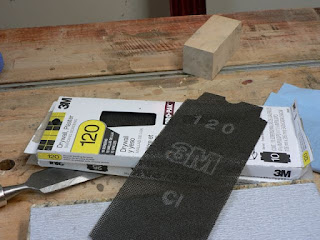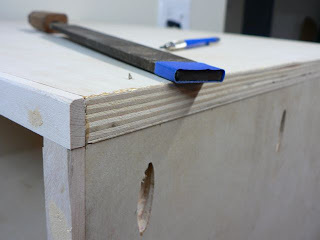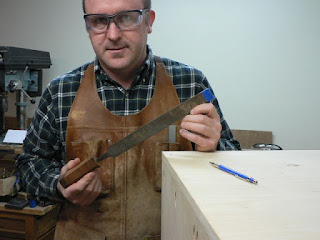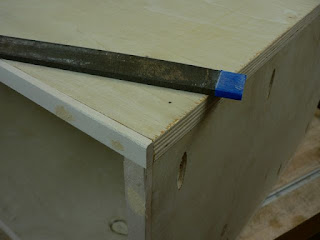I spent the weekend chauffeuring my 14-year-old to anime conventions, haircuts, pet shops, etc. In between chauffeur runs I worked on installing drawers in my shop cabinets. And I used this "jig" to do it.
The first time you mount a drawer on metal slides (a.k.a. runners), and see the intricate way the slides have been manufactured, and all the tiny little numbers on the specification sheet (some of them in millimeters with Euro hardware), you might think you need to buy a $30 jig that helps you drill the screw holes in the right places.
That jig might work just fine, and people I deeply respect say good things about the Rockler jigs for installing hardware, but I'd rather save my $30 for something else, and save the space that jig would take up in my very small shop.
What's the alternative? I show one possibility here: a piece of sheet material from the scrap bin. As long as it's wide enough to support the drawer slide, and its two sides are parallel so the slide will end up level inside the cabinet, it can work as a fine drawer slide installation jig:
As you see, I simply lay the slide down on the top edge of the jig, position the front edge of the slide 5/32” back from the front edge of the cabinet using my adjustable square, and drive some screws.
Move the jig to the other side (it's double sided! ambidextrous! unhanded!) and install the other slide, which automagically ends up at exactly the same height! There you go: your drawer will be perfectly level inside the cabinet.
What if I don't know how tall to make the jig?
I was hoping you'd ask that. Use this as a chance to learn: make the jig close to what you think is the right height, install the slide and drawer, and see where the drawer is compared to where you want it. If it's 7/16” higher than you want it, make the jig 7/16” shorter and reinstall the slide. Chances are the screw holes from your first try will be covered. If they aren't, and somebody actually sees these screw holes, and then cares enough to ask about them, just roll your eyes, sigh, and ask "What's your problem with green woodworking?"
What if the jig is too short?
Say it's 2” too short. Find a long scrap 2" wide, and put that under the jig.
What about the next drawer?
Cut the jig shorter, and use it again.
What if I'm building face-frame cabinets?
Use a jig like this to install the blocking you use for installing the slides. You know, the blocking that kicks the drawer slide out from the cabinet side so it's flush with the inside edge of the face frame. Then use the jig (or one like it) to install the slides.
No more questions tonight. Well, maybe just one.
I really love this idea, and I want to beat it to death. How can I go about doing that?
Let's say you have a run of cabinets which have several drawers in each cabinet, all at the same heights. Make yourself a set of these jigs that stack together. Number them 1, 2, 3, 4 so that you always put them in the cabinet in the same order. Stack them all up, screw on a drawer slide, take off the top layer, screw on another slide, take off the next layer, etc.










































